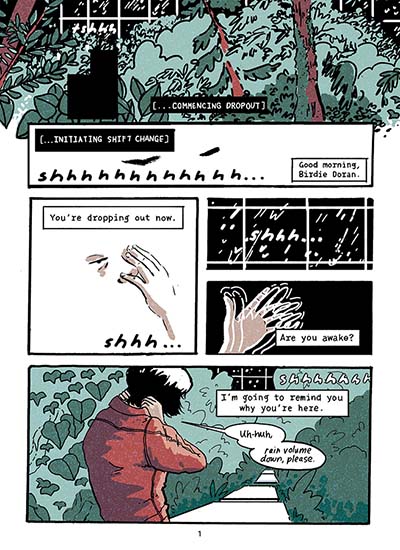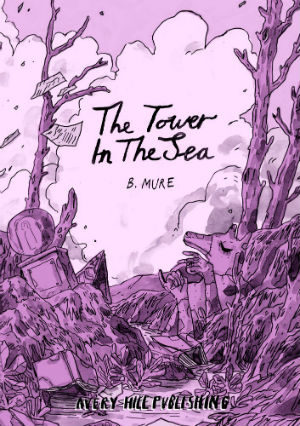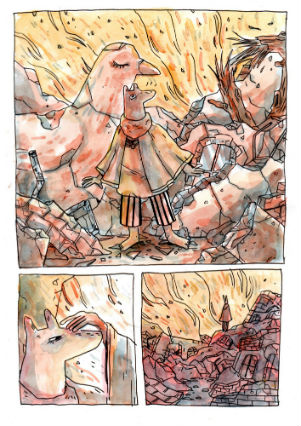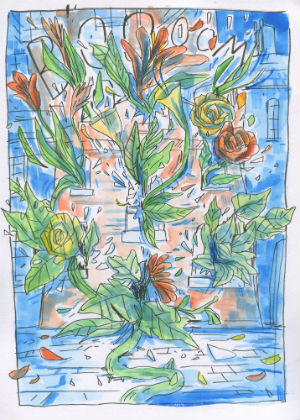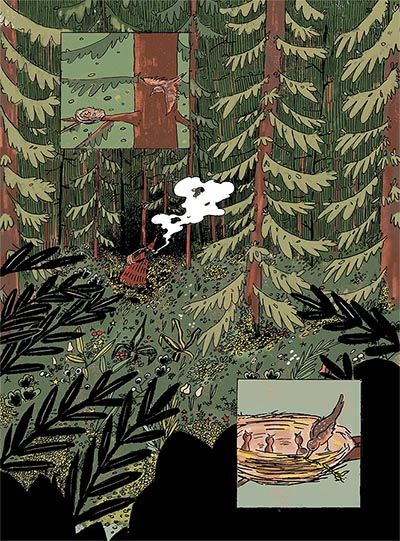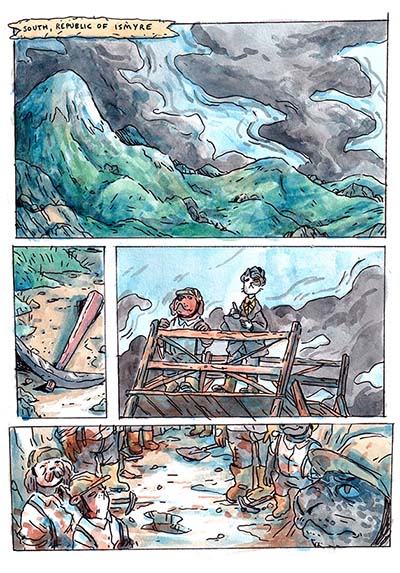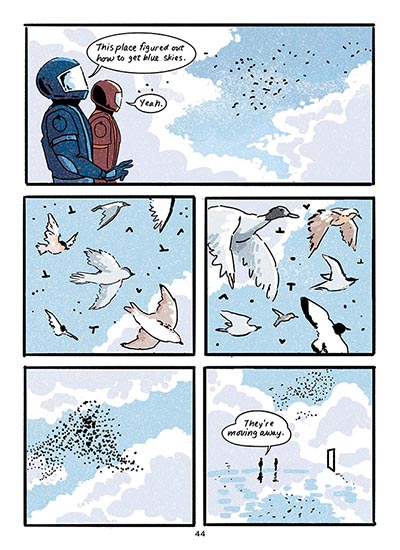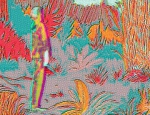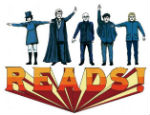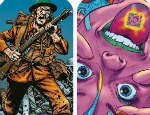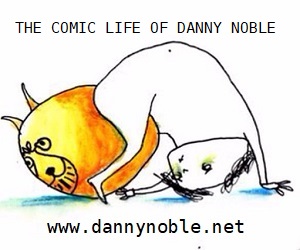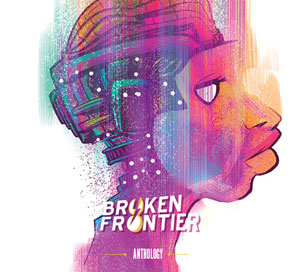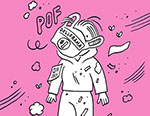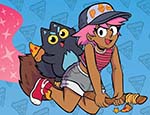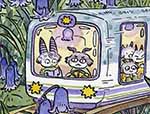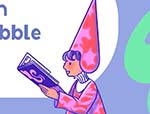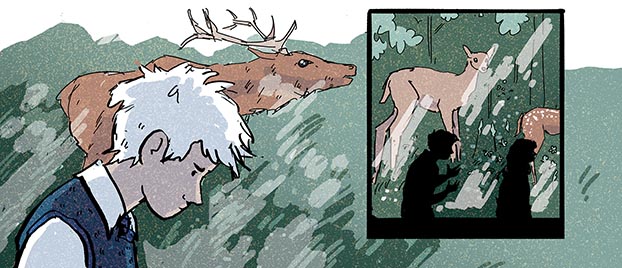
Something a little different today at Broken Frontier as Avery Hill Publishing creators B. Mure and Kit Anderson chat about their work, inspirations and world-building in fiction. Mure you will know, of course, from his Ismyre books at AHP, fantasy stories of which we said at BF “we are seeing a truly classic comic series emerging here.” Anderson’s Avery Hill debut came last year with Safer Places, a collection of stories about “isolation, memory, liminal spaces, and small magic.” Anderson’s latest AHP book, discussed below, is Second Shift which is currently crowdfunding on Kickstarter here. The graphic novel is described as “a psychological science fiction exploration of the lines between reality inside and outside the mind.” Over to B and Kit…
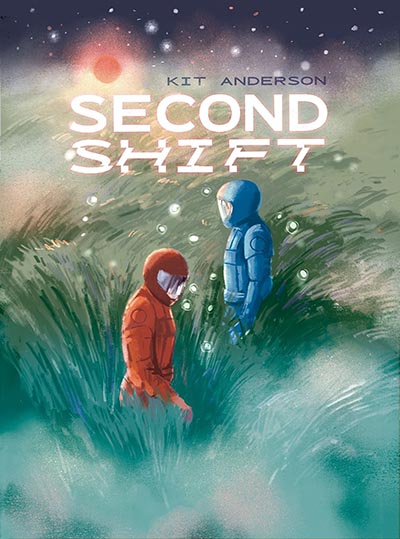
B. MURE: First and most importantly: please tell me about your dog.
KIT ANDERSON: I would love to. Her name’s Bobo/Bowie, a very young nine years old. She’s from a California shelter and goes with us pretty much everywhere—our little adventure buddy. It’s funny cause when I went into the shelter I was looking for a big dog like I grew up with—little ones weren’t even on my radar, but she kind of stole our hearts—immediately so curious and sweet. She’s eight kilos of pure attitude, but also the laziest dog ever. Indoors she’s a sleepy little baby, outside she’s an action hero. She’s perfect and I love her so much. Same question!
B: Ohh I love that! Very funny you ended up with a small dog too, I always had visions of having a huge dog when I was a kid and then when I could have a dog was like “oh no, these tiny terrier things are going to rule my life.” Parsnip is eight in September and he is my biological son. He’s similar to Bowie in that he loves to go charging around outside, but can be very snuggly and lazy in the house, and also has to be involved in every conversation. Me, my partner, and my sister have this ongoing joke that he is a tyrannical business man and every bark is him going BUY BUY BUY SELL SELL SELL.
Whereas Misty is nearly four, she’s a rescue street dog and a permanent baby. She has some hypermobility and joint issues and she’s quite nervous and just breaks every human heart she comes across. A tiny, stinky angel.
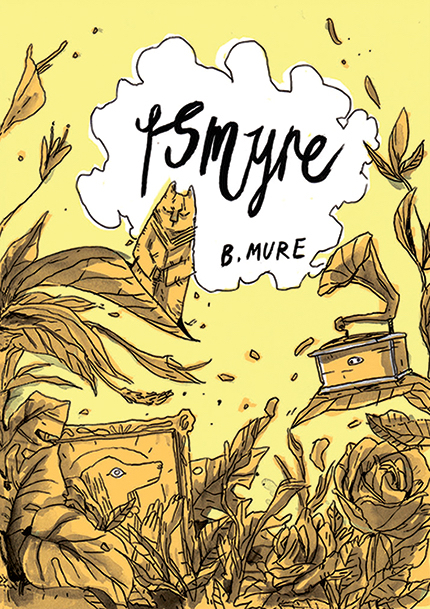
I love to see anthology comic work spanning across a few years! Did you ever try making your own comics as a kid? Did you ever have some sort of crystallizing moment at any age where you felt like, ‘yes! gotta make comics!’?
KIT: I think I did a lot of writing little stories and illustrating them myself, but I don’t think I took the leap into comics until much later. Even as an adult, they were really hard for me to figure out for a while (I’m definitely still figuring them out/hope I never feel like I totally have), so that’s why I was like “I think I need to go to school for this.” As far as a crystallizing moment, it’s hard to say.
I used to write a lot of prose short stories but among other speed bumps my writing got kinda tackled down by a mentor-type person which made it so that all felt bad for quite a while—it took me years even to admit to myself that I wanted to make things again. I found myself reading a lot of them while I was in a job where I had a bit of energy and creativity to spare, a little time to take drawing classes, etc., and I could look up and have dreams or whatever again, and I don’t know, one day it just felt kind of . . . possible and exciting. It was a slow burn, lots of trying to sneak up on it until I was ready. But basically making comics felt totally different—it was this whole other form to explore without all this baggage. I love them for that.
From Kit Anderson’s Second Shift
B: I say this with the caveat that people often ask me which of my books I’m proudest of and I know that my answer changes day to day! That said, even if it is just for today, is there one story in particular that holds a special place for you?
KIT: I’m gonna cheat and name a few for different reasons. The first I’d say is Quests, just cause it was so fun and sort of even easy to make—it felt like “I want to do this forever.”
Another is Weeds—it was sort of healing to work on, and then I got to work with the wonderful folks at Parsifal Press to publish a riso mini, which made it feel really kinda complete. My hope is it’s healing for other people, too.
The third would be the only nonfiction-type comic I’ve made so far, it’s called Their House (you can find it on The Rumpus). It was difficult to make (subject matter-wise, and it was stretching my abilities for sure), but it was one of my early comics where I can see myself really falling in love with the form.
B: What are some of your major influences? Talking novels, other comics, music, any other kind of media?
KIT: I’m sure it’s true for you, too, but dang, so many. I’m gonna limit myself to like individual prose books, comics, and movies/try to distill some examples. Books: Dark Tales by Shirley Jackson, The Illustrated Man by Ray Bradbury, Left Hand of Darkness by Ursula K. Le Guin, To the Lighthouse by Virginia Woolf, Roadside Picnic by the Strugatskys . . . are all big in my mind (but so are many more). For comics I always kinda point to Boundless by Jillian Tamaki, How to be Happy by Eleanor Davis, and A City Inside by Tillie Walden. Films: Solaris and Stalker, Alien/Aliens, and the show Twin Peaks.
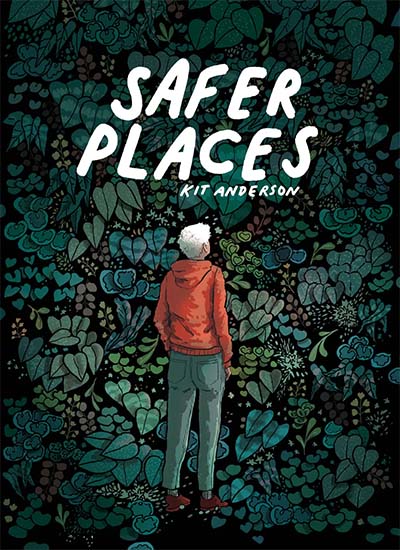
B: Throughout Safer Places I feel this sort of theme of longing and belonging and it often gives me this very human, heart-achey kind of feeling (in a good way!) I’m curious as to how you decided to pick which comics to put together (even if it was entirely vibes based!!)
KIT: The collection was foundationally my MFA thesis, so it has that first controlling factor of most of the stories being from a particular period of time. When I started making the collection I felt very editorially-minded, like “these are the stories I want to include, these are my themes, I want them to connect to each other in these ways, etc.” but it started feeling contrived and weird. So much about writing (for me) is where my head is at the time, where I’m walking, who I’m talking to, what I’m reading, what I’m seeing, all that. And these inspirations or whatever are so fleeting in a way, they can be really exciting at the time but if I don’t kinda realize them on their own for whatever they are, the engine kinda gets weak.
I had a lot of stories planned, some scripted and ready to go, but by the time I was “ready” to work on them I was somewhere else, so I just started concentrating on particular stories and letting them be whatever they wanted to be. Sometimes I came back to them (like with Quests and Sleep Tapes) when there was more I wanted to say (those make sense to me because I was always listening to things like meditation and sleep tapes at the time, and I was always walking in the forest). I guess what feels important is that these were all created in a particular moment. I had just moved here (to Switzerland) and it was still the height of the pandemic; it was so beautiful here, and I was open and grateful to it, but of course there were other things and feelings going on too.
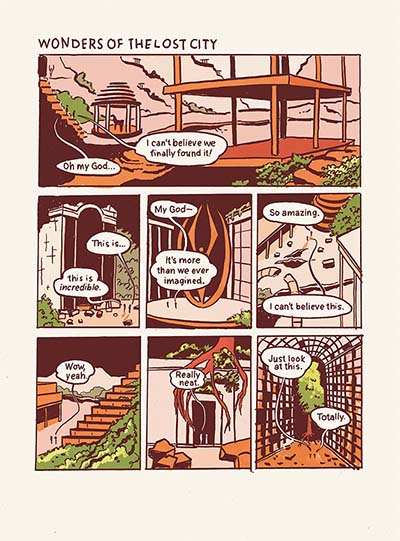
From Kit Anderson’s Safer Places
I left some of my stories out in the end (with Ricky Miller’s encouragement) because they weren’t the right feeling—that “safer place” being reached, but I also added a few later on (new and old) that felt like they belonged there, too. Collecting them/putting them in their order was probably mostly vibes/theme-based. I think some of them do speak to each other more directly, and I tried to make them feel a bit hinged when that was the case, but their order was mostly intuitive, I’d say.
B: What are your comics plans for the future? Do you have any ideas bubbling away that you want to pursue, or any projects you can talk about?
KIT: Yeah! So one of the stories in the collection, “Lookout Station,” is kind of a jumping-off point for the next book I’m working on with Avery Hill—it’s going to be called Second Shift. I’m loving working on it—I’m really excited about where it’s going, but it’s wild working on longer works. I tried to sort of treat it like I would a short story, but it’s not the same at all, really. Meanwhile I’ve been getting these somewhat inconvenient story ideas (inconvenient cause I don’t have time to work on them right now), and I’m looking forward to sitting down with some of those once the book is turned-in. It’s been so cool and good for my brain to work on a longer project, but I also love short stories and want to get back to those for a bit (experiment on a smaller scale, play with different mediums again, stuff like that).
What about you, B.? Follow-up question, do you do anything special to balance your short and long works? Does it feel the same for you to work on both types, or is that (most likely) too reductive?
B: Ohh, that sounds great, I’m really looking forward to your next book!
Yeah it’s tough, I feel like I never make enough time for shorter stories as I’ll get so tied up in work-work to live and then go, ‘noooo I can’t spend time on this, I have to get so many things done. . . .’ But likewise, I think doing that ‘experimenting on a smaller scale’ thing is so beneficial in terms of any sort of comic works. So I’ve got a few that just exist in note and sketch form. I’m trying to carve out dedicated spaces to spend on these a couple times of month, but it’s a constant effort (and like you, ideas for those things always happen to me when I’m working on something longer-form!).
In terms of long-term stuff, I used to be able to get down to work so much faster, but since having covid late 2021 and a couple of periods of burnout (plus that increased living cost!) I’m a lot slower. Which is obviously, you know, fast isn’t sustainable forever even without this! I feel like I’m still trying to work out my new pace (this is where I give a shout out to Avery Hill and their huge amount of support and patience!).
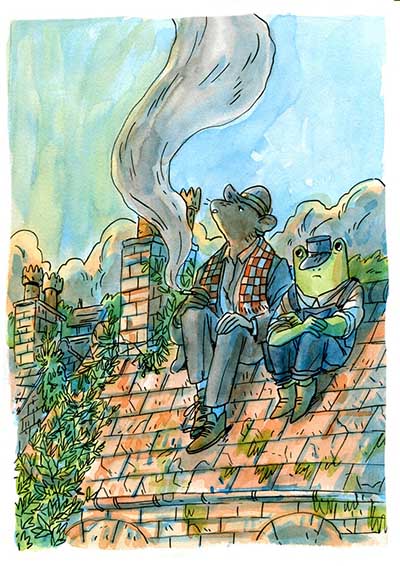
From the world of B. Mure’s Ismyre
Further to that, ‘cos I love this question that does the rounds on social media every now and then and am always curious about: if you were able to pick any sort of intellectual property or franchise to do a comic of, what would it be?
KIT: Haha great question. I think about adaptation sometimes—would love to do some old gothic stories, for example, but as far as something more contemporary…I would want to make a Twin Peaks Agent Cooper spinoff comic where we just follow him on his investigative and culinary adventures. Or The X- Files? I sound really hot for the FBI, I guess. I also have a huge soft spot for fantasy worlds (especially ones with animals, Ismyre very much included!) that always feels so welcoming and generative. Wanna arm wrestle for Redwall? But actually now that I’m really thinking about this, the Abhorsen books are old favorites that would be so fun (and challenging!) to adapt, I think. Sorry to keep doing this, but what about you?
B: I really want to read all of these!! Agent Cooper’s Culinary Adventures… I joked about it before but I think a big Redwall-inspired comics anthology would be so good. Also, I’d totally forgotten about the Abhorsen books, I loved those so much when I was younger for their unflinching, unpatronising approach to death and grief. I think your work would work so well for them..
From B. Mure’s Ismyre
Books are definitely big up there. I’d love to do The Plague Dogs or maybe some adaptations of some of the Mabinogion, but have to do my heritage a solid and learn more Welsh first. Also related to that, there’s this Dianne Wynne Jones story called Dogsbody (which has some references to Welsh mythology, as well as some bonkers 70s sci-fi elements) that I am slightly obsessed with. Unshockingly, many dogs involved in a lot of these. . . . Ohoh! I’m also a big sucker for the Marielda arc of Friends at the Table and there’s lots in that, in that location that would be so enjoyable to draw.
I don’t know if you do this too, but I love to make a playlist while I’m working on a book, ha! If you were going to pick one (or a couple) or songs that feel thematically right for Safer Places, what would they be?
KIT: This is hard! I’m all over the place with music on any given day, but I’d say “I’m not falling asleep” by Andy Shauf is probably one song I can point to that feels right. I want to know some of yours for Ismyre!
From Kit Anderson’s Safer Places
B: I love the throughline in the book with the wizard. Particularly I enjoy how open and expansive the space he is in feels and how that contrasts with some of the more interior stories in between. All of your settings feel very grounded though, which I enjoy. How much does your own environment influence the sort of stories you want to tell?
KIT: Oh wow, probably huge amounts! But it’s hard to say if my lived-in or remembered environments are more influential. I’ve lived in quite a few regions, and have been lucky to be more-or-less close to so many kinds of natural beauty, and these are always at the front of my mind. But yeah, place and memory (or lack of memory) are something I’m always kind of thinking about/exploring in my comics. I don’t have anything new to say on the importance of our environment, but I know that feeling like a very small part of it is the best thing for me (and my stories).
When did the world of Ismyre start for you (i.e., the first images and characters, scenes, doodles, daydreams, etc.)? I think I read somewhere that it began when you were a teenager–if that’s the case, how has it grown up with you? How present has it been in your life?
Related: what were some things that set young B.’s mind on fire as a young person? What media etc. fed your imagination? Or: what were some inspirational worlds to you as a kid? Are there sibling fantastical worlds out there that you think of? Also related: I’d dearly love seeing early sketches if that’s something you have/are willing to share…
B: I think maybe I was around fifteen or sixteen? It was really different then, with people instead of animals and had a real focus on the contrast of a heavily bureaucratic society and escaping for freedom. I was really into the film Brazil at the time, haha! and a ton of other sort of dystopian type films, like Twelve Monkeys and The City of Lost Children which I think was partially me being annoyingly like “oh, I am a grown-up sophisticate now” except still very excited about Pokemon.
From B. Mure’s Disciples of the Soil
But I’d always really liked kind-of sad stories involving creatures too, like the animated series Animals of Farthing Wood and Watership Down. I really wanted to write the whole thing, but it never ended up happening (mostly in that real adolescent way where you build up a story too much but never figure the whole thing out while simultaneously feeling too embarrassed by your own work to actually do it). I sort of forgot about it for years, but I think the idea and sort of flavour of the setting stuck with me.
When I was in my final year of university I did a workshop with writer and collage artist Graham Rawle where we made 100-word stories and illustrations from them, which was born out of the same setting and ideas and directly influenced the first Ismyre book. I have the image somewhere and I think it’s in an old interview, but I cannot find it for the life of me. I did find some older drawings a while back (below), I wish I had more! Gonna have to hunt through some sketchbooks. This is when Ed was a guy, who was much different in personality and also had a hot air balloon (Faustine’s personality is much closer to this Ed actually!)
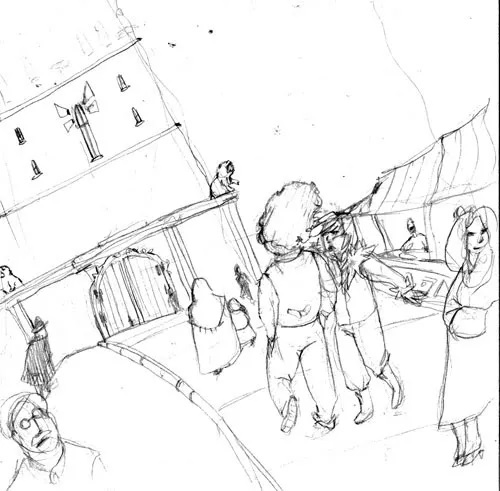
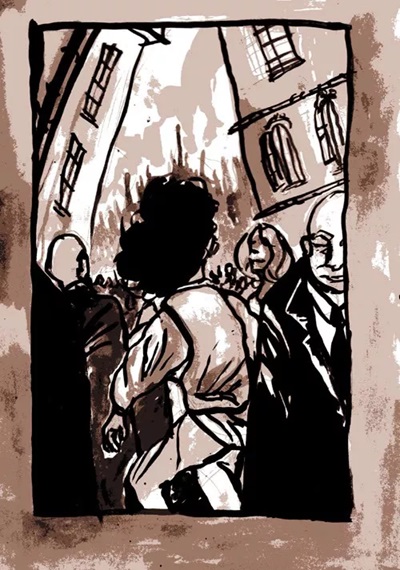
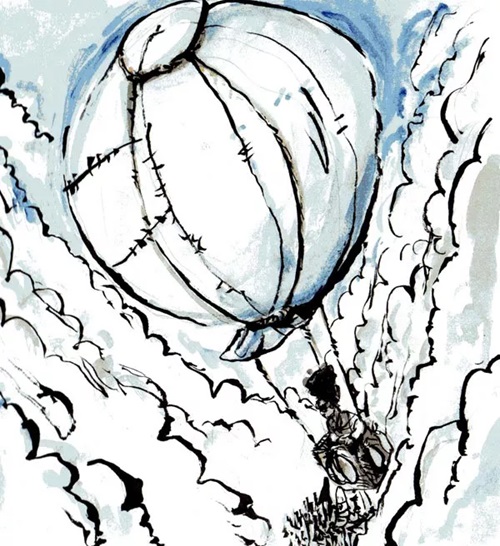
KIT: Can you describe how you’ve filled in the lines of this world, and how these explorations have informed your books? I guess I mean, is it world or story first for you? Do you see a tower in the sea and then imagine what happens inside, or do you want to tell a story about young resistance and the rest follows? I was so impressed by the breadth of Postcards of Ismyre–the world-building in there! Anyway, I get the sense it’s a flexible and evolving world there for you to draw from, but also it feels like this intricate and full thing that we’ve only seen a small piece of . . . but how does it work for you?
B: Ahh thank you! Sometimes it feels to me like I am hodgepodge crafting a weird castle out of paper mache and continually sticking other bits on. Which isn’t to say that it isn’t considered at all, but it’s hard for me to look at and try and see if it feels like one whole thing to other people.
I feel like world and story happen for me in this kind of tug-of-war throughout working on an Ismyre book. For the most recent book, I knew it was going to be focused on unrest but ALSO I just definitely wanted to draw a train and then went down this hole about considering how a railway would function in Ismyre, how a locomotive would be powered and then I got really fixated remembering those scenes of people in an early cinema running away from a filmed steam train and thinking their eggs would get all weird. . . .
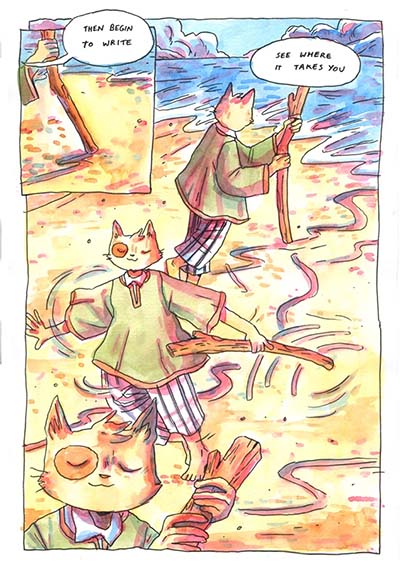
From B. Mure’s The Tower in the Sea
But also, thinking about it now, I think more than anything the sensation or feeling is so important for me initially. If I have an idea for an image that evokes this tangible sensation in my chest I sort of want the place and story to sprout out of that, if that makes any sense!
KIT: I remember when I saw the first explosion in Ismyre–it’s such a beautiful, pervasive image; I love it so much, and I think about it often–the same is true for the last page of Terrible Means. If you had to point to an image or panel, etc. that sums-up the foundation you’re building from/your guiding star, what would it be?
B: Yess there’s a few! There’s some pages of Ed in his flat at the beginning of Ismyre that I look back at a lot, this image of the detective in Methods of Dyeing walking through the streets and, the last page of Terrible Means does really do it too! They all have this kind of quiet feeling to them that anchors me to what I’m doing (below).
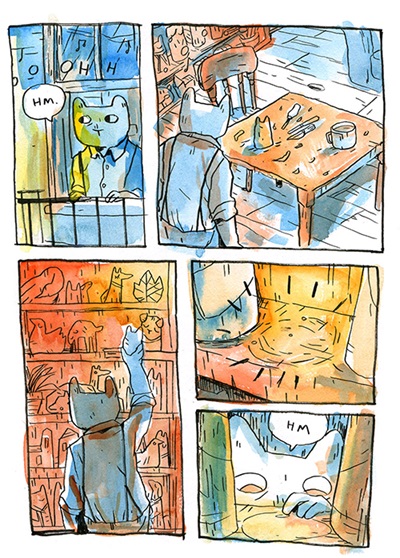
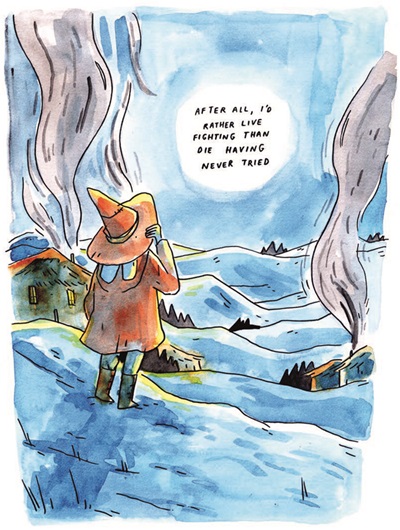
KIT: I love how diverse your animal folk are (not just forest animals, or traditionally “cute” ones), and how you imbue so much individual personality into them/their expressions–among my favourites are the amphibian and reptile folk. Still, what are animals that would never show up? For example, I’ve never seen a spider person . . . how do you determine this?
B: Yessss I love to draw a weird animal! I’m a big fan of drawing the reptiles, too. I sat down a couple of years ago and actually thought about this after having an Arthur-related panic where I was like, “oh god did I draw birds in the sky? But there are bird people….”
As far as I’ve decided, there are no fish people (sea dwelling mammals and amphibians are okay though because not fish). Even though it doesn’t really matter if it does not make perfect sense, I could not get my brain around it enough (this could change at any point when I decide what a background crowd needs is a fish person making a strange expression).
From Kit Anderson’s Second Shift
And no insect people because!! As vaguely mentioned in Methods of Dyeing there are areas of the world that have giant bugs as livestock, which would be a very fun thing to get more into. I always love a bug horse. I hadn’t considered arachnids though and now I’m going to have to have a serious think.
KIT: Do you see yourself as representing Ismyre stylistically, or is the world actually made of these kaleidoscopic watercolors/2D drawings and loose lines? This is to say: how close are the Ismyres between what you see in your mind and what we see on the page? Has this image changed throughout your time there?
B: Oooh! This is very interesting! I had never thought about it! I think to me it is mostly a stylistic representation but a lot of what I imagine in my mind when I think about it is very textural and sense-based. When I was younger, it was definitely much more literally image-based, much more precision (that I could never recreate!) and now I think back, much more brown/grey!
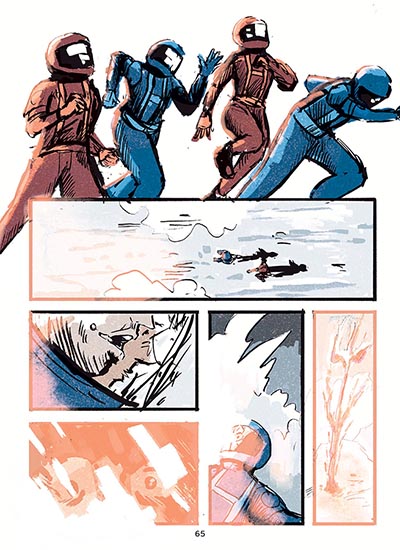
From Kit Anderson’s Second Shift
KIT: What does this world offer you as a storyteller that a world more like ours doesn’t? To be broader (and perhaps more annoying): why genre for you?
B: Magic airships!! But genuinely I think things based more in the real world and real world fantasy can offer just as much as each other depending on the story you’re telling. I couldn’t tell you why exactly, only that these were the certain sort of stories I wanted to tell at the time and as I inhabited that space more, more questions arose from it that informed further stories (I guess that is what I call world-building).
Not to say I don’t like stories that are set in our world or worlds more like them! I’d like to do some short stuff more like that. I think it’s one of those pieces of advice that is always so true that it’s genuinely really beneficial (and enjoyable) to make work in the fantasy genre and read, like, Cormac McCarthy, to explore anything totally outside the remit of what you’re doing.
KIT: Do you have any particular influences (in terms of eras, etc.) for architecture and fashion?
Related: do you have any source books etc. you look at regularly? Are there things you like having around you to reference while you’re building Ismyre out?
B: There’s a historical architect from Nottingham, Watson Fothergill who influenced me a bunch. Not that the buildings are exactly that, but the man did love a decorative turret. It’s a real hodgepodge in terms of eras and pinning anything down, but I look at images and street views of Krakow and Prague quite a lot, look at lots of Victorian era stuff, and a lot of labourers outfits from the 30s.
I always have a host of books by my desk I can pull from and in my shared studio, we’ve put a lot of our reference books on a shared bookshelf nearby. Online access to ref is good but nothing beats just being able to grab a book. When I was planning the last book, I borrowed my partner’s copy of Alchemy & Mysticism by Alexander Roob which was great to just flick through.
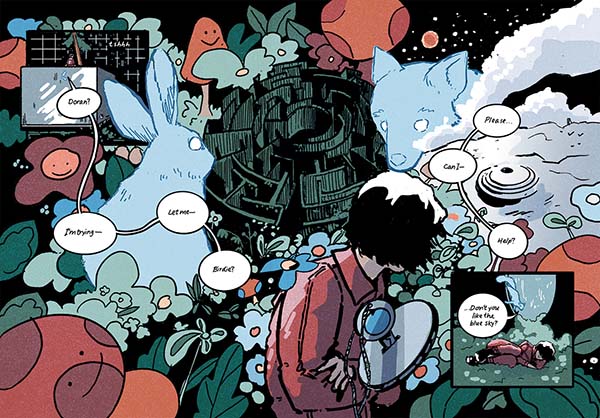
From Kit Anderson’s Second Shift
KIT: Ismyre is complex in its structures of power/economy/ecology/magic–there seems to be this pull towards a soft and beautiful chaos (with the protagonists and eco-anarchists helping that along). The way you’re expressing the philosophies operating in your world reminds me of the way creators like Miyazaki and Le Guin holistically weave their beliefs into theirs. What are some philosophical influences on Ismyre? Or: if you imagine a bookshelf in, say, Emyln’s house, what are a few titles one might see there?
B: Oh, lots and lots. Some big ones off the top of my brain that have: Peter Kropotkin, Donna Hayward, Octavia Butler, Barbara Hepworth, Louise Michel and LeGuin herself.
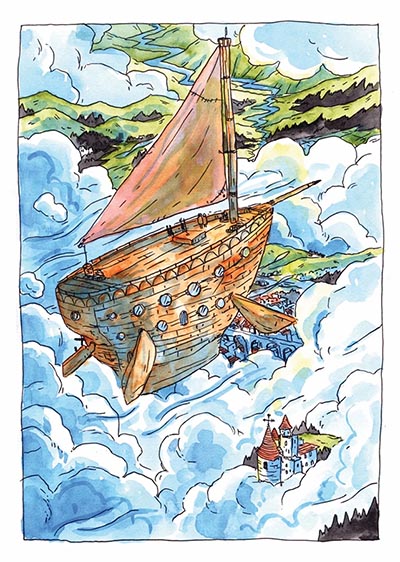
From B.Mure’s Terrible Means
KIT: What would you look like in Ismyre? What’s your occupation?
B: I feel like I’d be some kind of Jack Russell looking casual gardener and street caricature artist in permanent dungarees. I’m going to do it back now because I want to know: what about you!
KIT: Haha, I’d probably opt to be a hedgehog who works in a cozy little local archive and keeps weird hours and goes to the same bakery every day. I love how so many of your characters have scarves–mine would be patchy/often repaired flannel, and my glasses would always be smudged.





